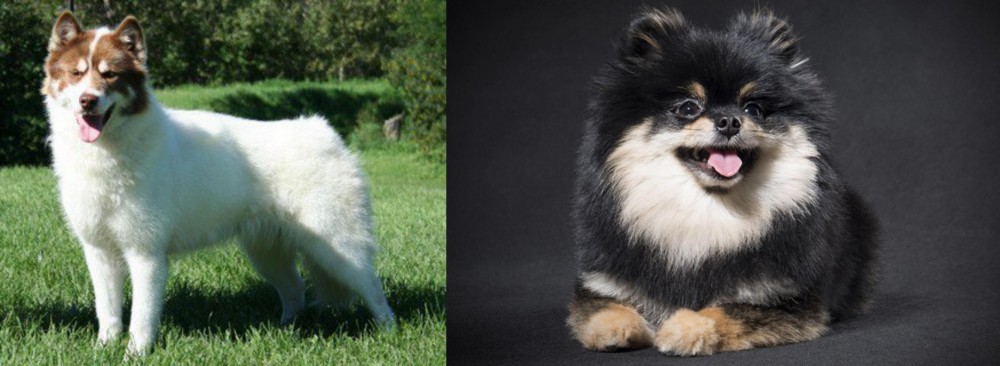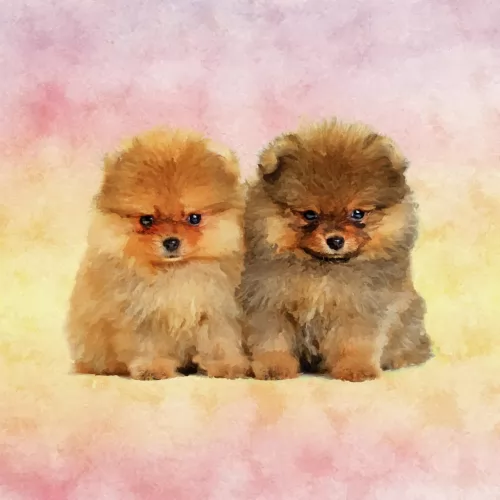 Petzlover
Petzlover Canadian Eskimo Dog is originated from Canada but German Spitz (Klein) is originated from Germany. Canadian Eskimo Dog may grow 45 cm / 18 inches higher than German Spitz (Klein). Canadian Eskimo Dog may weigh 30 kg / 67 pounds more than German Spitz (Klein). Both Canadian Eskimo Dog and German Spitz (Klein) has same life span. Canadian Eskimo Dog may have more litter size than German Spitz (Klein). Both Canadian Eskimo Dog and German Spitz (Klein) requires Moderate Maintenance.
Canadian Eskimo Dog is originated from Canada but German Spitz (Klein) is originated from Germany. Canadian Eskimo Dog may grow 45 cm / 18 inches higher than German Spitz (Klein). Canadian Eskimo Dog may weigh 30 kg / 67 pounds more than German Spitz (Klein). Both Canadian Eskimo Dog and German Spitz (Klein) has same life span. Canadian Eskimo Dog may have more litter size than German Spitz (Klein). Both Canadian Eskimo Dog and German Spitz (Klein) requires Moderate Maintenance.
 The Canadian Eskimo Dog dates way back to more than 4,000 years ago. This Arctic breed of dog was developed to pull sleds, and wasn’t considered as a pet but as a working dog – an important means to an end – a tool for use.
The Canadian Eskimo Dog dates way back to more than 4,000 years ago. This Arctic breed of dog was developed to pull sleds, and wasn’t considered as a pet but as a working dog – an important means to an end – a tool for use.
By the 1960s the dog breed had declined to such an extent that they were removed from UKC and AKC registries. It is believed that the breed would have in all likelihood become extinct if it weren’t for the efforts of Brian Ladoon, William Carpenter and John McGrath who formed the Eskimo Dog Research Foundation in 1972.
After breeding for 30 years, the dog has the biggest genetic stock colony of Canadian Eskimo Dogs and in May 2000, Nunavut, a Canadian territory, adopted the dog as the animal symbol for this region.
 Also referred to as the Miniature Spitz, the German Spitz is believed to have descended from the Nordic Samoyed and Lapphund. Some dog experts say they were developed from the larger European Spitz, and that they were once referred to as Pomeranians.
Also referred to as the Miniature Spitz, the German Spitz is believed to have descended from the Nordic Samoyed and Lapphund. Some dog experts say they were developed from the larger European Spitz, and that they were once referred to as Pomeranians.
It is also thought that these dogs were in all likelihood brought over to Germany during the Middle Ages. This gives you an idea as to how ancient the breed is. There are actually 4 different Spitz breeds, divided by their sizes.
The dogs were originally used as herding and guard dogs, but today you could say that this toy breed is essentially a companion dog.
 The Canadian Eskimo Dog is a well-built, medium- to large sized dog looking much like a husky. The male Eskimo dog is somewhat bigger than the female, standing 58 – 70cm at the shoulder and weighing 30 - 40kg.
The Canadian Eskimo Dog is a well-built, medium- to large sized dog looking much like a husky. The male Eskimo dog is somewhat bigger than the female, standing 58 – 70cm at the shoulder and weighing 30 - 40kg.
The male often has some thick fur around the neck, giving him the appearance of looking larger than he actually is. He is slightly larger than the female. Other people say he has a similar appearance to a wolf.
He has a thick double coat which can be white, gray, fawn or even black and white. He has short, erect ears, dark brown eyes and a bushy, feathered tail which curls over the back. Sometimes you find blue eyes with the Canadian Eskimo Dog, and its only when you want to show him, that this isn’t acceptable.
The Canadian Eskimo Dog's temperament is hard working, tough, brave, alert and intelligent. When he is trained and socialized, which will be important for this breed, he becomes gentle and loving, forming a strong bond with his owner. He’ll also get along well with children in the home as well as other pets.
 Classified as a toy breed, the German Spitz Klein looks like a small fox with his thick fur. He stands at between 23 – 28cm in height and he weighs 5 to 10kg.
Classified as a toy breed, the German Spitz Klein looks like a small fox with his thick fur. He stands at between 23 – 28cm in height and he weighs 5 to 10kg.
He has a sharp foxy face with small pointed upright ears and dark, bright eyes.
The double coat of the dog which can be fawn, cream, reddish, brown or black or a mixture of these colors, is straight, vibrant and off-standing to look at. He has a soft woolly undercoat. The tail of the dog curls up over the back.
The German Spitz Klein has got such a bright little face. He is a social, friendly dog, forming a strong bond with his human family. He is a smart dog too and can be easily trained.
Lively and independent, he is bold and adventurous. Even with a small dog like this, he will do well to be trained and socialized as he just becomes a better dog -obedient and relaxed around strange people and dogs.
Because of his size, he adapts well to life in the city or in the countryside. This is also because he doesn’t require a lot of exercise. The litter size for the German Spitz Klein is between 1 and 5 puppies.
 The Canadian Eskimo Dog is a dog which is responsive to training. With training and socialization, as a highly intelligent, strong-will dog he will need to be supervised by a firm, authoritative figure.
The Canadian Eskimo Dog is a dog which is responsive to training. With training and socialization, as a highly intelligent, strong-will dog he will need to be supervised by a firm, authoritative figure.
He makes such an awesome pet when properly trained, and if you’re a responsible dog owner who knows how to care for- and exercise your pet appropriately, you’ll be rewarded by having a strong, loving companion at your side.
 This litle dog is seriously a case of ‘dynamite in a small package’. Bold, daring, brave, spunky, clever, playful and friendly, your confident little German Spitz Klein makes most families the perfect pet and companion.
This litle dog is seriously a case of ‘dynamite in a small package’. Bold, daring, brave, spunky, clever, playful and friendly, your confident little German Spitz Klein makes most families the perfect pet and companion.
Give him the love and attention he deserves, especially because he is undemanding and low maintenance, and with good care you’re going to have a most adoring companion for more than a decade.
 The Canadian Eskimo Dog is a generally healthy breed who has a life expectancy of between 10 and 15 years when he is lovingly cared for and provided with a top quality diet. Ensure that he has a top quality diet with plenty of raw meat geared towards his age and energy levels.
The Canadian Eskimo Dog is a generally healthy breed who has a life expectancy of between 10 and 15 years when he is lovingly cared for and provided with a top quality diet. Ensure that he has a top quality diet with plenty of raw meat geared towards his age and energy levels.
The Canadian Eskimo Dog suffers from common health issues that most dogs are at risk for, and typically this will include hip dysplasia and eye disease. If your dog develops a disease such as hip dysplasia, speak to your vet immediately.
 You’ve got a pretty healthy little dog breed but be that as it may, it doesn’t make him totally immune to some of the common dog diseases there are. With him, you might want to look out for eye disease and epilepsy.
You’ve got a pretty healthy little dog breed but be that as it may, it doesn’t make him totally immune to some of the common dog diseases there are. With him, you might want to look out for eye disease and epilepsy.
Glaucoma occurs when there is pressure in the eye. Your dog will have pain, red eyes, dilated pupils, increased tear production and corneal cloudiness. You want to have him at the vet for this because putting off treatment can lead to blindness.
This is a condition that can gradually lead to blindness even though the eyes look normal. Difficulty with seeing at night is one symptom. Fortunately the condition is painless and your dog finds ways to cope with the problem.
It is always a good idea when you suspect anything wrong with your pet, to get him to the vet as soon as possible.
 The Canadian Eskimo Dog has always been a working dog, used to being driven hard to perform, and to this day he likes to work hard and have his day filled with activities.
The Canadian Eskimo Dog has always been a working dog, used to being driven hard to perform, and to this day he likes to work hard and have his day filled with activities.
His exercise requirements are high and this is one breed that you’re going to have to exercise regularly – long walks, running on a leash as you cycle, ball games, swimming, hiking. It is why the dog is best suited for life in the country as opposed to small properties in the city. If exercise seems like a lot of hard work for you, don’t buy such a breed as it will be cruel and irresponsible to leave him day after day in your back yard. He becomes bored, frustrated, unhappy and destructive.
The dog is an average shedder and his coat is short and dense. There’s not a whole lot of maintenance to worry about with this good-looking dog and he will basically require having a good brush twice a week.
 As a feisty small-sized dog breed, your foxy little German Spitz Klein needs to get the very best food there is. If you are going to feed him a high-quality commercial dog food, make sure to read the ingredients on the packaging and buy him food according to his size and age. Mix in some home-made food from time to time and always ensure he has constant access to cool, fresh drinking water.
As a feisty small-sized dog breed, your foxy little German Spitz Klein needs to get the very best food there is. If you are going to feed him a high-quality commercial dog food, make sure to read the ingredients on the packaging and buy him food according to his size and age. Mix in some home-made food from time to time and always ensure he has constant access to cool, fresh drinking water.
He has a fairly long, thick coat, so a good brush twice a week will be adequate. While you’re brushing him, check him over for fleas and ticks too.
Always check his teeth and brush them a couple of times a week too. Bad teeth can cause a host of problems, not only with the teeth, but other parts of the body too.
He is an active, jaunty little dog that loves all kinds of games. Being a small breed, he isn’t going to be the kind of dog that you need to include in your jogging or cycling trips, but he is no couch potato, and he will love to go on a walk with you, and it also does him good to get out and about for a change of scenery.